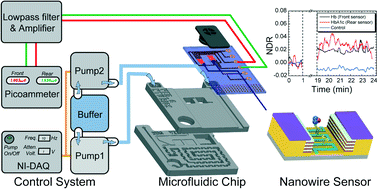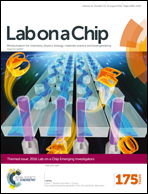A microfluidic device integrating dual CMOS polysilicon nanowire sensors for on-chip whole blood processing and simultaneous detection of multiple analytes†
Abstract
The hemoglobin-A1c test, measuring the ratio of glycated hemoglobin (HbA1c) to hemoglobin (Hb) levels, has been a standard assay in diabetes diagnosis that removes the day-to-day glucose level variation. Currently, the HbA1c test is restricted to hospitals and central laboratories due to the laborious, time-consuming whole blood processing and bulky instruments. In this paper, we have developed a microfluidic device integrating dual CMOS polysilicon nanowire sensors (MINS) for on-chip whole blood processing and simultaneous detection of multiple analytes. The micromachined polymethylmethacrylate (PMMA) microfluidic device consisted of a serpentine microchannel with multiple dam structures designed for non-lysed cells or debris trapping, uniform plasma/buffer mixing and dilution. The CMOS-fabricated polysilicon nanowire sensors integrated with the microfluidic device were designed for the simultaneous, label-free electrical detection of multiple analytes. Our study first measured the Hb and HbA1c levels in 11 clinical samples via these nanowire sensors. The results were compared with those of standard Hb and HbA1c measurement methods (Hb: the sodium lauryl sulfate hemoglobin detection method; HbA1c: cation-exchange high-performance liquid chromatography) and showed comparable outcomes. Finally, we successfully demonstrated the efficacy of the MINS device's on-chip whole blood processing followed by simultaneous Hb and HbA1c measurement in a clinical sample. Compared to current Hb and HbA1c sensing instruments, the MINS platform is compact and can simultaneously detect two analytes with only 5 μL of whole blood, which corresponds to a 300-fold blood volume reduction. The total assay time, including the in situ sample processing and analyte detection, was just 30 minutes. Based on its on-chip whole blood processing and simultaneous multiple analyte detection functionalities with a lower sample volume requirement and shorter process time, the MINS device can be effectively applied to real-time diabetes diagnostics and monitoring in point-of-care settings.

- This article is part of the themed collection: 2016 Lab on a Chip Emerging Investigators

 Please wait while we load your content...
Please wait while we load your content...